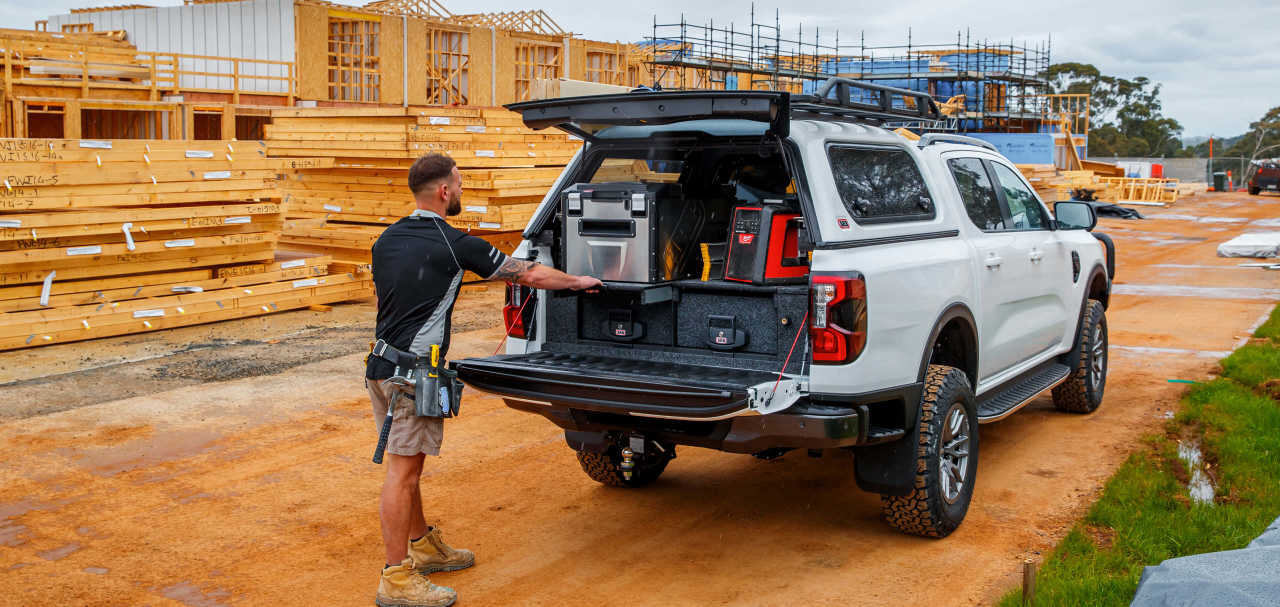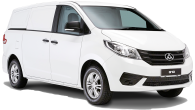Not all commercial enterprises require medium-sized commercial vans like the Toyota HiAce or Hyundai iLoad with 2.5-3.5 tonne GVM capacity. That's why there's a healthy market for under-2.5 tonne GVM versions tailored to suit small to medium-sized businesses and fleets.
The Renault Kangoo has traditionally been a strong seller in this segment and its latest MY2017 model has the sales-leading Volkswagen Caddy in its cross-hairs, with a new high-efficiency turbocharged petrol engine and seven-speed dual-clutch auto combination providing increased power and torque with reduced fuel consumption, emissions and running costs.
Renault Kangoo 2017: 1.2 SWB
| Engine Type | Turbo 4, 1.2L |
|---|---|
| Fuel Type | Premium Unleaded Petrol |
| Fuel Efficiency | 6.5L/100km (combined) |
| Seating | 2 |
| Price From | $12,980 - $17,270 |
Is there anything interesting about its design?
The Kangoo features typically quirky but cute European styling with non-glazed sliding doors on both sides of the cargo bay and a glazed swing-up tailgate as standard.
The front-wheel drive L1 SWB Compact rides on a 2697mm wheelbase with an overall length of 4213mm and width of 1829mm. MacPherson strut front suspension and power-assisted steering are matched with a well-designed beam rear axle featuring torsion bar primary springing and a pair of 'booster' coil springs for competent carrying of heavier loads.
The Kangoo's low seating position relative to its 1815mm overall height results in a surprisingly airy and spacious cabin environment for such a compact vehicle. Even tall drivers can feel vertically challenged given the huge amount of headroom and expansive height of the windscreen.
How practical is the space inside?
With a 1270kg tare weight the L1 SWB Compact with EDC has a GVM (gross vehicle mass) of 1810kg which allows for a maximum payload of 540kg. This is 135kg less than the six-speed manual version's 675kg.
The EDC-equipped Kangoo's GCM (gross combined mass) is the same as its GVM of 1810kg so it's not rated to tow anything. If you need to hook up a light trailer the manual version is your only option, as it has a GCM of 2295kg and is rated to tow up to 1050kg of braked trailer.
It can also swallow a standard 1160mm-square Aussie pallet which is impressive for such a small vehicle.
However, drill down into these robust figures and you discover that to tow a trailer of that weight and stay within the legal GCM limit would require the tow vehicle to weigh no more than 1245kg. And that's the manual Kangoo's tare weight with only 10 litres of fuel in the tank, no driver and no tow-ball download! The devil's in the detail, as they say.
Our advice would be to stick with the lower 660kg limit for un-braked trailers and have a more realistic 390kg of payload to play with, so that you can include lots of useful items like a full tank of fuel, the tow-ball download – oh, and a driver.
The cargo bay features a load floor protector and mid-height wall linings including the tailgate, plus internal lighting and 10 well-placed tie-down points. A wheel-changing tool kit is mounted in a neat plastic case on the right-side wheel housing.
The cargo bay's length of 1476mm and internal height of 1251mm provides 3.0 cubic metres of load volume. With a generous 1218mm between the wheelarches, it can also swallow a standard 1160mm-square Aussie pallet which is impressive for such a small vehicle. Many one tonne utes can't do this.
Storage options for driver and passenger include a bottle holder and storage pocket in each door, a deep cubby (more like a small cave) in the centre dash pad and a smaller one above the single glove box, plus a centre console with two cupholders and a lidded storage box that doubles as an arm-rest.
Does it represent good value for the price? What features does it come with?
The Kangoo range comprises L1 SWB Compact and L2 LWB Maxi and Crew variants. The L1 SWB Compact is available only with the new 1.2 litre petrol engine in a choice of six-speed manual ($23,490) or the new six-speed 'EDC' (Efficient Dual Clutch) as fitted to our test vehicle ($26,490).
.jpg)
Standard features include 6 x 15-inch steel wheels with centre caps and 195/65 R15 91T tyres with a full-size spare, height-adjustable steering wheel, cruise control, a fairly basic audio system with steering wheel-mounted controls and Bluetooth connectivity, a 12-volt outlet, reverse parking sensors, rear screen wiper/washer and a pair of vertical cargo protection bars behind the driver to name a few.
There's also an extensive genuine accessories range, which includes lots of useful stuff like a premium R-LINK media interface with 7.0-inch touchscreen, sat-nav and rear view camera, overhead storage shelf, full steel bulkhead between cabin and cargo bay, glazed rear twin barn doors and side sliding doors to name a few.
.jpg)
What are the key stats for the engine and transmission?
The Kangoo's new all-aluminium, direct injection, turbocharged 1.2 litre four cylinder petrol engine is a variant of the unit shared by some of Renault's popular passenger cars with revised tuning to provide more power and torque at lower rpm for this work-focused load-lugging role.
With 84kW at 4500rpm the new Euro 6-compliant engine offers 6kW more power than the 1.6 litre unit it replaces and achieves it some 1500rpm lower in the rev range. Peak torque of 190Nm is a 42Nm gain over the previous engine and available across a broad rev band from 2000-4000rpm.
.jpg)
The new 1.2 litre is also 10kg lighter with a low friction timing chain designed to last the life of the engine. The lower rpm focus also means less noise, vibration and wear along with reduced emissions and a substantial 21 per cent improvement in fuel economy.
The six-speed EDC has gear ratios and shift protocols tailored to suit the new engine's characteristics, providing brisk acceleration from standing starts with fast and near seamless shifting. Engine rpm at highway speeds has also been reduced by 23 per cent with only 2240rpm at 100km/h. There's also a sequential manual shift mode if required.
How much fuel does it consume?
Renault claims a combined cycle figure of 6.5 litres/100km but in 'real world' driving our figures based on trip meter and fuel pump readings came in at 8.3 litres/100km. Our test included a variety of driving conditions and loads, without using the Eco mode.
What's it like to drive?
Renault makes some great small capacity drivetrain combinations and this is one of them. Smooth, quiet and efficient, it provides brisk acceleration from standing starts even with a full payload, which is ideal for stop/start driving in busy CBD delivery zones. The steering is lightly weighted and responsive and the four-wheel discs provide reassuringly strong braking.
Tall drivers will find the airy and spacious cabin accommodating with comfortable seating and most controls well placed, including a smooth dashboard contour around the gearstick which the left leg often rests against. The large left footrest is also well positioned for this.
We loaded 415kg into the cargo bay, which with a full tank of fuel and driver equalled its 540kg maximum payload rating. On our notoriously bumpy test route the Kangoo's suspension handled this load with great composure, tracking straight without a hint of bottoming out or being thrown off-line by road surface irregularities or side winds.
Our only major gripe is the substantial tyre noise that emanates from the large rear wheelarches.
Using the excellent cruise control, the engine required only 2250rpm to maintain 100km/h and 2300rpm at 110km/h. It also performed well on our set climb with this payload. The EDC held fourth gear at 2000rpm and 60km/h for most of a 2.0km 12-13 per cent gradient, with only one self-shift down to third and 3200rpm to clear the steepest section. Engine braking was minimal on the way down, but that's not unexpected given the engine's small capacity.
Our only major gripe is the substantial tyre noise that emanates from the large rear wheelarches. It starts to become noticeable at about 40km/h and is highly intrusive (like the roar of a jet engine) by the time you reach 100km/h. We hope, like Renault's larger Trafic van, that a steel bulkhead becomes standard issue in future Kangoo models, not only as a noise insulator but also a superior cargo barrier than the current minimalist twin-tube frame behind the driver (a steel bulkhead is available as a dealer-fit option).
We also think the door mirrors should be larger, with at least the lower 40 per cent of the passenger-side mirror in wide angle view, given that the sliding side doors are not glazed and the driver has no rear-quarter vision over his/her left shoulder. Without the optional reversing camera, this creates a large and potentially hazardous blind spot.
Warranty & Safety Rating
What safety equipment is fitted? What safety rating?
The Kangoo's four-star ANCAP rating falls one short of the maximum. Safety features include driver and passenger front and side airbags, ABS with emergency brake assist, electronic stability control, hill start assist and 'Grip Xtend' (intelligent traction control) but no AEB. The car also features 'R.A.I.D' (Renault Anti-Intruder Device) which automatically locks all doors when speeds reach 30km/h, rear fog lights and reverse parking sensors.
What does it cost to own? What warranty is offered?
Renault offers a three year/200,000km warranty on the Kangoo, with three-year 24/7 roadside assistance.
Recommended service interval is 12 months/15,000km, whichever comes first. A capped price of $349 is set for the first three scheduled services.
Verdict
According to Renault Australia, petrol-powered Kangoos have traditionally accounted for around 60 per cent of local sales. That customer preference is likely to continue and potentially grow given the positive attributes of the latest petrol engine and EDC self-shifter. As a light-duty delivery van the Kangoo is fit-for-purpose with few flaws. If Renault added a cabin bulkhead, larger door mirrors and a reversing camera as standard equipment it would fix all of them.
Is the Kangoo your next light-duty van? Tell us what you think in the comments below.
Pricing Guides




.jpg)
.jpg)
.jpg)
.jpg)
.jpg)
.jpg)
.jpg)
.jpg)
.jpg)
.jpg)
.jpg)
.jpg)
.jpg)
.jpg)
.jpg)

.jpg)


.jpg)



.jpg)
.jpg)


.jpg)
.jpg)

Comments